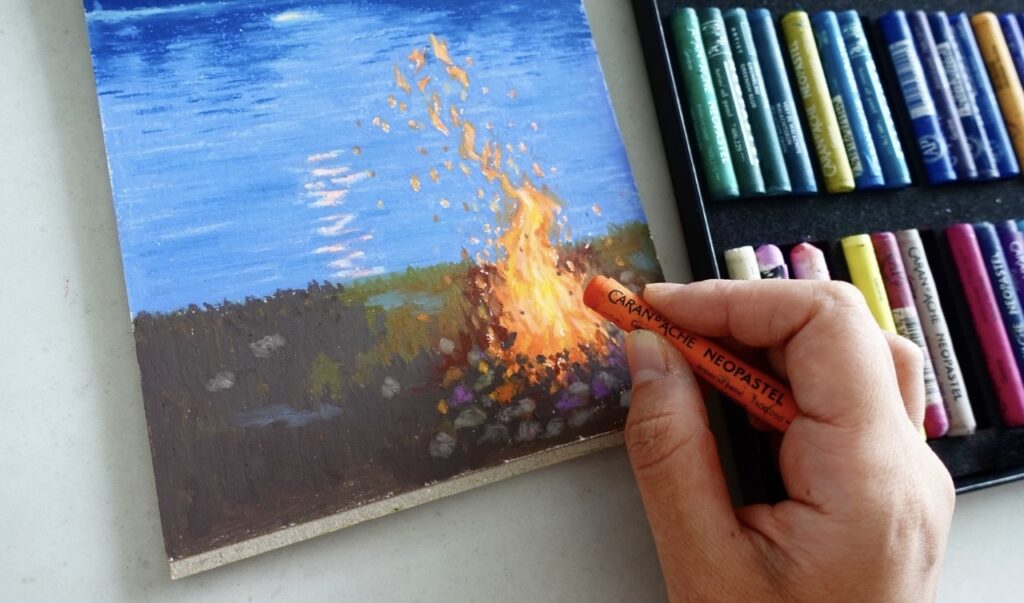Are you contemplating exploring the vibrant arena of oil pastel art? This in-depth guide provides everything you need to know to dive headfirst into this creative domain. You may be someone who has just acquired a new set of oil pastels or maybe you’re simply intent on expanding your existing artistic skills. Regardless, transitioning to a new medium can be daunting and requires a significant amount of research and practice. This article is designed to guide you through that journey, imparting valuable insights and tips that have been meticulously tested and selected for their effectiveness.
1. Essential Supplies for Novice Oil Pastel Enthusiasts
Embarking on your artistic journey necessitates:
An exquisite collection of oil pastels. Seek those that are pliable and merge effortlessly, steering clear of any that are rigid or desiccated. A judicious investment in superior artistic tools is fundamental for enriching and gratifying creative endeavors.
2. The Essence of Oil Pastels
Predominantly in stick form, oil pastels are an amalgamation of pigments, waxes, and mineral oils. This medium is remarkable, offering a lustrous finish akin to oil paints. They adhere to diverse substrates, boast vivid chromatic intensity, and enhance artworks with texture. Their blendable nature makes them suitable for expansive canvases.
3. Oil Pastels: A Viable Substitute for Oil Paints?
From my perspective, traditional paints and brushes reign supreme. However, for novices, oil pastels present an ideal alternative. Oil painting demands extensive preparation and a plethora of materials, unlike oil pastels. The latter are straightforward, necessitate no brushes or solvents, and are travel-friendly and mess-free. Comparatively economical, they also allow for techniques like scraping, layering, mimicking wet paint, or dry application.
4. Integrating Oil Pastels in Artwork
For beginners, any artistic technique can be daunting. Mastering drawing and blending with oil pastels requires practice and experimentation. Like all media, oil pastels have specific methods and tips to simplify the art-making process.
Varied Oil Pastel Blending Techniques
While finger blending is common, alternative methods like using stumps, kneaded erasers, or cotton swabs offer less messy options. Paintbrushes, both soft and stiff, are effective, as are unconventional tools like soft leather, fabric, or paper towels. However, be aware that these might also lift your color.
Blending with Oil
Yes, it’s feasible to blend oil pastel edges using linseed oil or similar oils used in oil painting. Just allow ample drying time.
Overlay Technique with Oil Pastels
Layering different oil pastel colors creates new hues, similar to mixing paint. Start with a primary color and build layers to achieve the desired shade.
Utilizing Masking Tape
Masking tape can create clean lines and edges. Tape areas you wish to leave untouched, removing the tape later to add further details or blend edges.
Sgraffito or Scratching Technique
Layer various oil pastel colors, finishing with a dark shade. Then, etch your design into these layers using a sharp tool.
Scumbling Technique
This involves scribbling across your canvas with at least two colors. Overlap these scribbles at various points to create a unique texture.
Advice for Novice Oil Pastel Artists
When beginning with oil pastels, consider these tips:
- Experiment with different brands to find your preferred oil pastel hardness;
- Store them appropriately as temperature impacts their hardness;
- Practice patiently; mastery comes with time;
- Explore various surfaces for different effects;
- Pre-blend oil pastels to preview colors;
- Feel free to combine different mediums in your artwork;
- Avoid resting your hand directly on the paper to prevent smudging;
- Regularly clean the pastel tips for crisp color blending.
Remember, your artistic journey is unique, and these guidelines are merely stepping stones to discovering your personal style and preferences in the vibrant world of oil pastel art.

Muted Colors Make All the Difference!
In the realm of oil pastel artistry, the power of muted colors is often underestimated. These subdued hues can add a layer of sophistication and depth to your work, creating an atmosphere that vibrant colors alone cannot achieve. Muted colors are not merely dull or less intense; they are complex, subtle, and can convey a range of emotions and atmospheres.
Incorporating Muted Tones in Oil Pastel Art
Muted colors can be especially effective in creating a sense of calm, nostalgia, or natural realism. They can be used to:
- Enhance realism: Muted tones are abundant in the natural world. Incorporating these into landscapes, portraits, or still lifes can add a realistic and relatable touch;
- Create mood: A palette dominated by muted colors can evoke emotions like serenity, melancholy, or vintage charm;
- Provide balance: In a composition bustling with bright colors, muted tones can offer a visual resting place, balancing the overall effect and preventing sensory overload.
Experimenting with muted colors in oil pastels can open up new avenues for creative expression. You can achieve these tones by blending complementary colors, using white or black to tone down the intensity, or even layering different colors to create a unique muted effect. The key is to explore and experiment, allowing these less vibrant but equally captivating colors to elevate your oil pastel artwork to new heights of expressive potential.
Wrapping Up
Embarking on the journey of oil pastel artwork is an enriching and fulfilling endeavor, brimming with endless opportunities for creativity. Despite the learning curve, this comprehensive guide aims to provide an easy transition and continuous skill development. Remember, consistent practice and experimenting with your creativity are pivotal in honing your skills and discovering new artistic possibilities. Happy creating!
